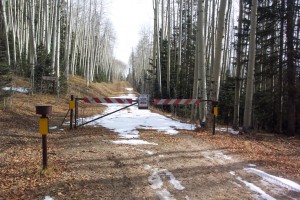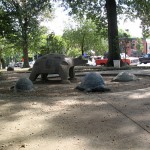If the government shut down the forest, and nobody was there to see it, would it still be there? Would the trees still live? Would the trails still lead anywhere? Would the deer and the antelope still play?
 If you think so, then you are among the tens of millions of Americans who think life still goes on despite a temporary government shutdown. You might even be so bold as to think your life is not especially diminished by having fewer government workers today. There are about 800,000 federal employees now on vacation as a result of the political impasse in Washington – you can think of it as a paid vacation because as soon as a deal is reached they will all receive back-pay.
If you think so, then you are among the tens of millions of Americans who think life still goes on despite a temporary government shutdown. You might even be so bold as to think your life is not especially diminished by having fewer government workers today. There are about 800,000 federal employees now on vacation as a result of the political impasse in Washington – you can think of it as a paid vacation because as soon as a deal is reached they will all receive back-pay.
So just in case you don’t think this is important enough to be angry at Congress, the Administration has decided to close the forests and parks to get your attention. In earlier cases we used to refer to this as the “close-the-Washington-Monument strategy,” meaning you close the things most people will be angriest about, so they will pressure their Congressman to get the money flowing again. Except this time, the Washington Monument was already closed, as it has been for more than two years. They could still close the Statue of Liberty, too, but people are getting used to that, too (it has only been open for 3 months this time). It was closed for 8 years after 9/11 and then only opened for a few people a day. It was closed again 2 years later for a full year of renovations, and reopened in October, 2012 – for one day. Then because of Hurricane Sandy it was closed again for almost another year. Finding these icons of national pride closed is no longer a big deal to visitors; it is routine.
This time around, the Administration had to dig deeper in its attempt to get the public angry over a temporary political impasse. And the agencies are willing to spend a substantial amount of money to make that happen. That’s why we are now seeing barricades and police cars surrounding dozens of open-air parks, cemeteries, monuments and memorials. These places do not cost the government more or less whether there are tourists visiting or not. Barricades and police cars are expensive, but that is just the price of playing politics with parks and forests.
Many news stories have shown angry 90-year-old World War II veterans breaking through the barricades to see the World War II Memorial – three days in a row. One Park Service policeman confirmed to a reporter that the order to spend extra money to block entry into this open-air memorial came not from National Park Service officials, but from the White House (proof that this is about politics, not budgets).
Closing honored graveyards such as Arlington National Cemetery and the American veterans cemetery at Normandy (there are hundreds of others) may stop patriots from putting flowers on the graves of their loved ones for a few days, but it does not save the government money – it costs more money.
 Yesterday a friend mentioned a small neighborhood park called “Turtle Park” because it has five large concrete turtles for kids to play on. It is smaller than the fences that were built around it to keep kids from playing there, and here is the best part – it is not a federal park. Rather, it is owned by the District of Columbia, whose Mayor made a big splash reassuring everyone that DC would not be affected by the government shutdown, because it had enough money in reserve accounts to keep all the employees working.
Yesterday a friend mentioned a small neighborhood park called “Turtle Park” because it has five large concrete turtles for kids to play on. It is smaller than the fences that were built around it to keep kids from playing there, and here is the best part – it is not a federal park. Rather, it is owned by the District of Columbia, whose Mayor made a big splash reassuring everyone that DC would not be affected by the government shutdown, because it had enough money in reserve accounts to keep all the employees working.
Similarly, federal police cars blocked entrances into an old farm called Claude Moore Park in Virginia – a very popular park with some of the area’s most heavily used soccer fields – even though the park is not federally funded. It is owned by the county, not the federal government, but it was closed anyway, just in case people thought they could go ahead with their local soccer leagues as if the political mess in Washington didn’t affect them.
Barricades have been installed at some entrances to popular trails across the country, from the old C&O Canal and the Appalachian Trail to the hiking trails of Crater Lake and Yosemite. Many of these outdoor locations have no staff to be paid or not paid, no regular employees whose wages are affected one way or the other by what Congress does or does not pass.
If you want more information about closures, don’t check the government websites. You will only find reminders that the agencies are closed. The National Park Service has actually spent money adding a new page to take the place of all its existing websites. It simply says: “Because of the federal government shutdown, all national parks are closed and National Park Service webpages are not operating.” The Forest Service website says “Due to the lapse in agency funding, the sale of all types of permits (i.e., recreation, firewood, forest products, mineral materials for example) are suspended, recreational reservations are suspended, and all federally owned recreation sites are closed. All offices are closed… Law enforcement, fire suppression, and other essential services will continue without interruption.” Reading between the lines, that means putting out forest fires is considered “essential” but preventing the fires with proper management is not.
Honestly, the distinction between “essential” and “non-essential” services is lost on many of us. Every time there is a government shutdown, employees designated as “essential” have to work anyway. This time around, we find that more than 60% of all federal employees have been so designated – far more than during the famous 1990’s shutdown. Some pundits are wondering if 40% of the workforce is “non-essential,” why we pay them at all. But I am not that cynical. Someone has to put up the barricades.




Comments on this entry are closed.